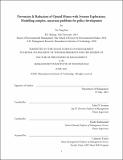Prevention & Reduction of Opioid Misuse with Systems Exploration: Modelling complex, uncertain problems for policy development
Author(s)
Lim, Tse Yang
DownloadThesis PDF (6.436Mb)
Advisor
Sterman, John D.
Rahmandad, Hazhir
Terms of use
Metadata
Show full item recordAbstract
The opioid crisis is one of the worst public health challenges in the United States, with overdoses killing over 50,000 people a year. The crisis is a complex and dynamic problem, with long delays and multiple feedbacks, in which any policy actions risk causing adverse unintended consequences. Recognising these challenges, in 2017, the National Academies of Sciences, Engineering, and Medicine recommended the development of a quantitative systems model to guide Federal government policy to address the crisis.
Here I present PROMISE, a dynamic simulation model of the opioid crisis developed in conjunction with the US Food and Drug Administration in response to that charge. The model encompasses misuse of prescription and illicit opioids, opioid use disorder, treatment and remission, and tracks a range of health outcomes. PROMISE is calibrated to the US population using 20 years of national-level data. It brings together a more comprehensive combination of endogenous feedback mechanisms and empirically-grounded operational details than any other model of the crisis.
Our baseline model estimates highlight the impact of supply-side changes, responses to perceived overdose risk, and the competing influences of illicit fentanyl and overdose prevention efforts in shaping the trajectory of the crisis. We find that fentanyl-driven increases in mortality far outweigh efforts to counteract them. Baseline projections indicate the crisis is shifting away from opioid use as surging mortality deters new initiates. These estimates yield the most thorough quantitative understanding of the historical trajectory of the crisis available to date, and provide a solid foundation for identifying and analysing policy solutions.
PROMISE also serves as a practical demonstration of applied simulation modelling in two ways – first, as an empirically-grounded model of a complex and highly uncertain problem, and second, as a model and modelling process developed in collaboration with policy-makers and deployed explicitly in support of policy decision-making. I conclude with reflections on the practice and process of modelling for decision support, on using the model in analytic and discursive ways, and on its limitations and directions for future work.
Date issued
2021-06Department
Sloan School of ManagementPublisher
Massachusetts Institute of Technology